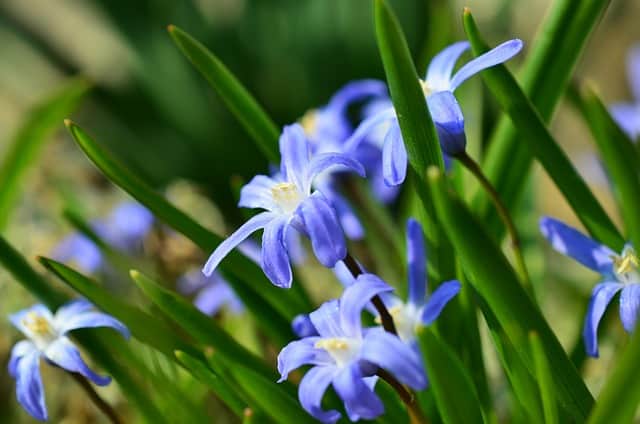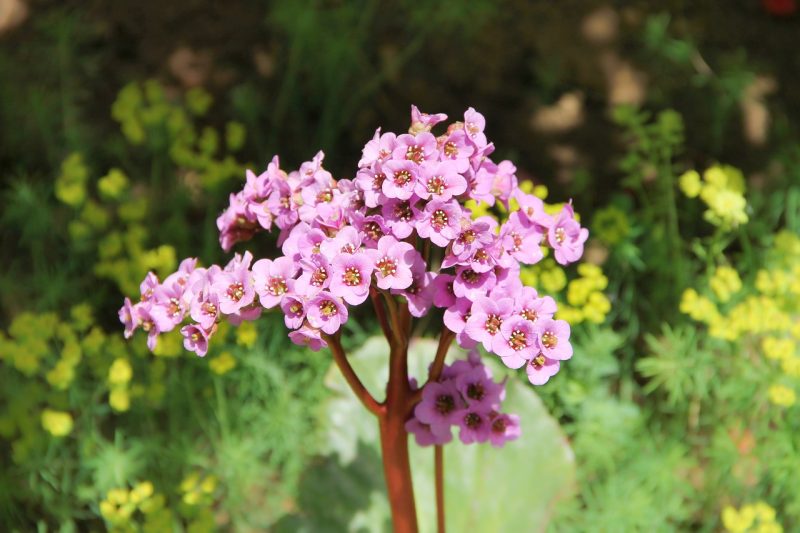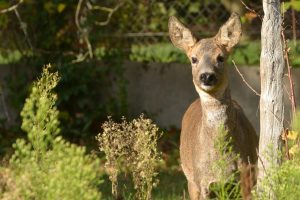As the chill of winter settles in, many gardeners may believe that their opportunities for planting colorful blooms have diminished. However, there are several hardy and beautiful winter flowers that can thrive in pots, adding vibrancy to your outdoor space even in the coldest season.
Early Crocuses

Early crocuses are some of the first harbingers of spring, poking through the snow to deliver a burst of color just as winter begins to wane. Their bulbous nature means they can be successfully grown in pots, where they can be nestled amidst other winter plantings for a visually appealing display. The range of colors extends from soft yellows and whites to deep purples and blues, providing an inviting palette for those dreary winter days.
When planning your pot arrangements, consider intermixing early crocuses with evergreen foliage to create contrast. Their ability to bloom in early spring, and sometimes even late winter, makes them perfect for stirring anticipation for the warmer months ahead. For optimal results, choose a well-draining potting mix and plant the crocus bulbs, pointed end up, at a depth of about two to three times their height. With a little patience, you’ll be rewarded with blooms that bring life to your winter garden.
Heucheras
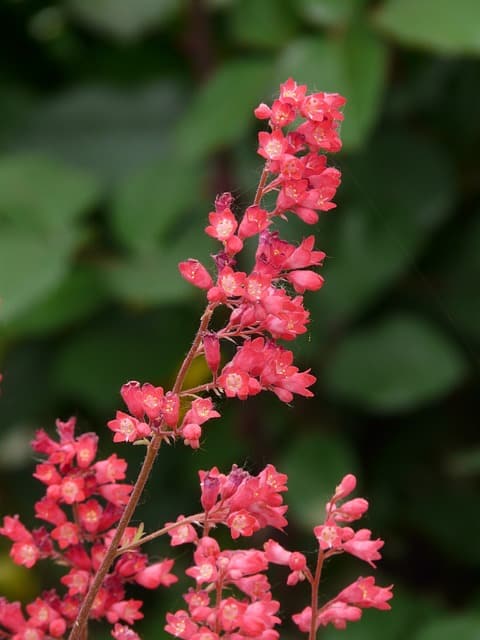
Heucheras, commonly known as coral bells, are another fantastic option for winter pots. Renowned for their vibrant foliage, these plants offer a stunning array of colors, including deep reds, purples, and bright chartreuse, which can remain attractive even under a layer of frost or snow. Their compact growth habit and versatility make them ideal for container gardening, creating a striking focal point during winter months.
One of the remarkable features of heucheras is their ability to thrive in a variety of conditions, from full sun to partial shade. This adaptability allows gardeners to place pots in diverse locations, maximizing visual impact throughout the cold season. To ensure that your heucheras flourish, use potting soil enriched with organic matter, and water them moderately, allowing the top layer to dry out between waterings.
For a stunning presentation, combine heucheras with delicately flowering winter annuals or ornamental grasses. This layering effect not only enhances visual interest but accommodates a range of textures and colors, perfect for brightening up dull winter days.
Pansies and Violas

When it comes to winter flowers for pots, few can compete with the resilience and beauty of pansies and violas. With their large, vibrant blooms and cheerful faces, these plants are synonymous with winter color and are perfect for anyone looking to make a statement in their garden or outdoor space. Pansies, in particular, are known for their impressive color array—spanning from classic yellows and purples to bicolored varieties and even striking black blooms.
One advantage of pots filled with pansies is their ability to flower during mild winter weather, and they can often survive through frosts. When planting, choose a quality potting mix that retains moisture without becoming soggy, as consistent watering is critical for keeping these beautiful flowers thriving. Deadheading spent blooms encourages further flowering, prolonging the colorful show well into spring.
Violas, closely related to pansies, are equally charming but typically smaller, providing a delicate touch to your winter container displays. Their sweet fragrance can also enhance the sensory experience of your garden. Both pansies and violas can be combined with other plants, such as heucheras or evergreens, to create layers of interest and bolster the overall beauty of your winter pots.
Heather
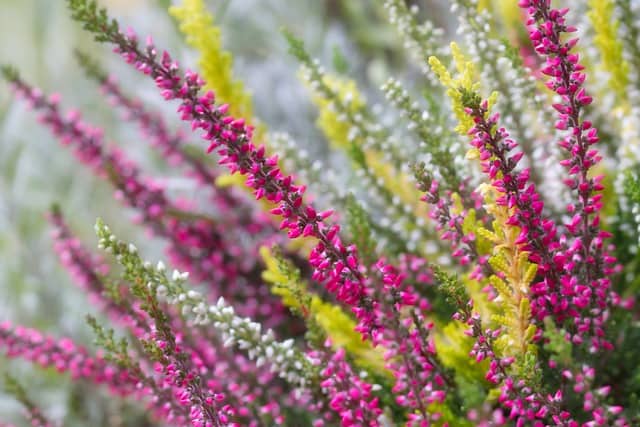
Heather, with its delicate flowers and evergreen foliage, is a quintessential choice for winter containers. This versatile low-growing shrub offers an enchanting display of tiny blossoms that bloom in shades ranging from soft pinks to striking purples, creating an inviting landscape even in the depths of winter. Its ability to thrive in colder climates makes it an excellent candidate for pots.
When selecting heather varieties for your winter displays, consider the growth habits and colors you prefer. The most common types, such as Calluna vulgaris, are well-suited for acidic soils, making them ideal for pots filled with a mix of peat and compost. For optimal blooming, place heather pots in locations that receive full sun; however, they can tolerate partial shade, which can help prolong their blooming season.
As a bonus, heather’s low-growing nature makes it an ideal companion for taller winter blooms, such as hellebores or even ornamental grasses. Not only will this layering of plants provide visual interest, but it will also create a more balanced look that highlights the beauty of each flower in your winter garden pots.
Hellebores
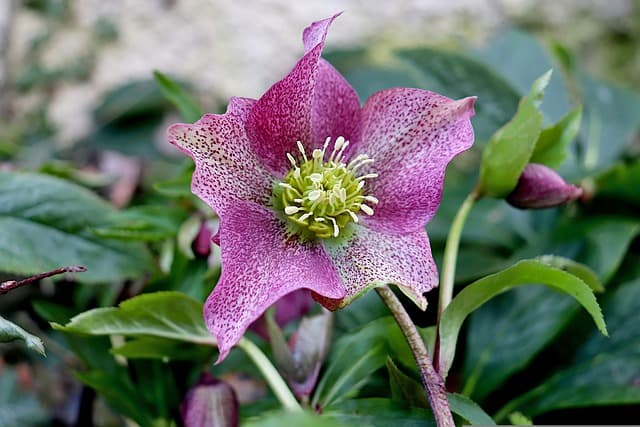
Hellebores, often referred to as Lenten roses, are an elegant addition to winter pots, renowned for their ability to flower when most other plants remain dormant. Their upward-facing blooms can range in color from muted hues to vibrant shades and come in charming shapes that catch the eye. These perennial plants not only add beauty to your containers but also serve as a vital food source for early pollinators.
To cultivate hellebores in pots, select a well-draining potting mix infused with organic matter. These plants prefer partial to full shade, making them perfect for those spots in your garden that are sheltered from harsh winter sun. One of the striking features of hellebores is their resilience; they can tolerate frost and even thrive in the snow, making them one of the ideal choices for winter containers.
Layer your hellebores with other complementary plants such as evergreen ferns or winter-blooming bulbs like snowdrops. This combination not only enhances the visual interest of your pots but also creates a lush, textured look that captures the essence of winter beauty.
Japanese Skimmia
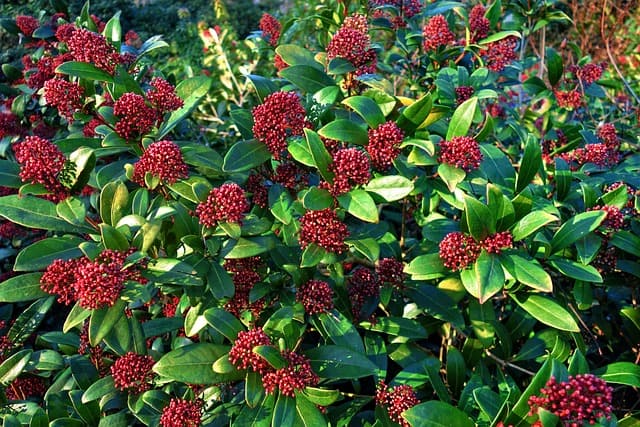
Japanese skimmia is another wonderful option for winter pots, known for its glossy green leaves and aromatic white to pink flowers that bloom in the late winter or early spring. This evergreen shrub adds richness to your winter arrangements, as its foliage remains vibrant all year long. Skimmia is particularly appealing for its compact growth and adaptability, making it ideal for container gardening.
For these plants, select a pot that is slightly larger to allow for adequate root growth. Japanese skimmia thrives in well-draining, acidic soil and can flourish in partial shade, which makes it suitable for various locations. The scented flowers attract pollinators, providing essential resources during the long, cold winter months.
To create an exceptional winter pot display, consider pairing skimmia with contrasting plants like soft-coloured heather or heliotrope. This combination introduces a variety of textures and colors into your winter landscape, making the overall arrangement visually captivating. Additionally, the foliage’s deep green color pairs beautifully with seasonal decorations like pinecones or twinkling fairy lights, enhancing the festive feel of your winter garden.
Camellia
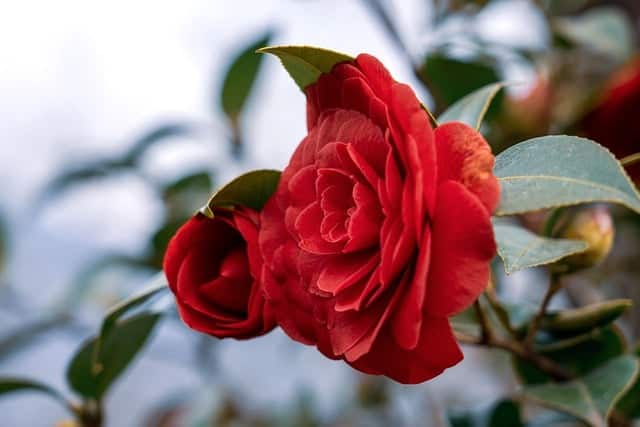
Camellias are a true winter treasure, revered for their large, lush blooms that can brighten even the dreariest days. Depending on the variety, camellias can feature flowers in shades of white, pink, and red. These evergreen plants provide a dramatic focal point in any winter container arrangement, making them a favorite among gardeners seeking seasonal splendor.
When planting camellias in pots, it’s essential to choose a large enough container to accommodate their root system, as they can grow quite dense. The ideal mix for these acid-loving plants is a well-draining soil combined with peat or pine bark to maintain the necessary acidity. Ensure the pots are placed in a location that receives dappled sunlight or partial shade, ideal conditions for these stunning shrubs.
Camellias not only contribute gorgeous blooms during winter but also keep their glossy leaves throughout the year, adding ongoing visual appeal. Consider planting them alongside frost-tolerant companions like heather or winter jasmine, which can offer a diverse display of textures and colors in your winter garden arrangement. With proper care, camellias will thrive and come back year after year, providing a long-term source of beauty in your outdoor space.
Cyclamen
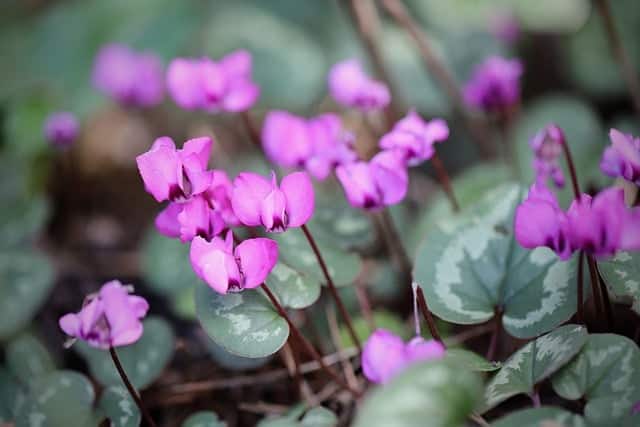
Cyclamen are charming perennial flowers that bring a delightful touch to winter pots. With their unique heart-shaped leaves and elegant, nodding blossoms, often in shades of white, pink, and deep magenta, cyclamen are perfect for adding both color and grace to your winter arrangements. The plant’s natural beauty is complemented by its ability to bloom during the colder months, often delighting gardeners with flowers when many other plants lay dormant.
Cyclamen prefer cool conditions and thrive in well-draining potting mix that allows for good airflow around the roots. Position them in a sheltered area that receives bright, indirect light. Be mindful not to overwater; these plants do best when the soil is allowed to dry out between watering sessions. Cyclamen are particularly suitable for containers, as their tuberous roots can flourish in confined spaces while their petals dance gently in the winter breezes.
For a captivating winter display, combine cyclamen with fragrant pansies or ferns for a lush arrangement. The contrasting foliage of these plants alongside the delicate blooms of cyclamen will create a striking visual contrast, ensuring your winter pots remain dynamic and appealing throughout the season.
Snowdrops
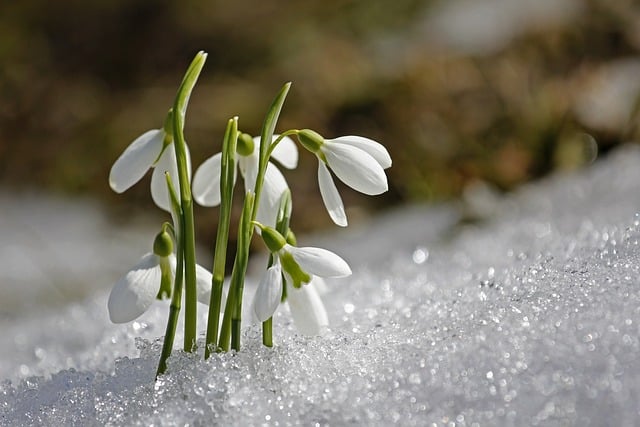
Snowdrops are whimsical little gems that signal the impending arrival of spring, making them a perfect addition to your winter flower pots. These bulbs, with their pristine white flowers drooping gracefully, can bloom as early as late winter, often peeking through the snow. Their enchanting appearance and hardy nature make snowdrops ideal for brightening up your winter arrangements.
When planting snowdrops in pots, choose a container deep enough to accommodate their roots, as they thrive in well-draining soil enriched with organic material. Plant bulbs before the frost sets in, positioning them at a depth of about three times their height. Snowdrops prefer partial to full shade, making them suitable for various sheltered locations in your garden.
Pairing snowdrops with evergreen plants like boxwood or contrasting perennials such as hellebores can create a beautiful layered effect in your winter pots. The delicate snowdrops will bring a sense of lightness and hope to your arrangements, signaling the eventual transition from winter to spring. Not only do they add stunning visual appeal, but their early blooms also provide a crucial source of nectar for bees emerging from dormancy.
Wintergreen
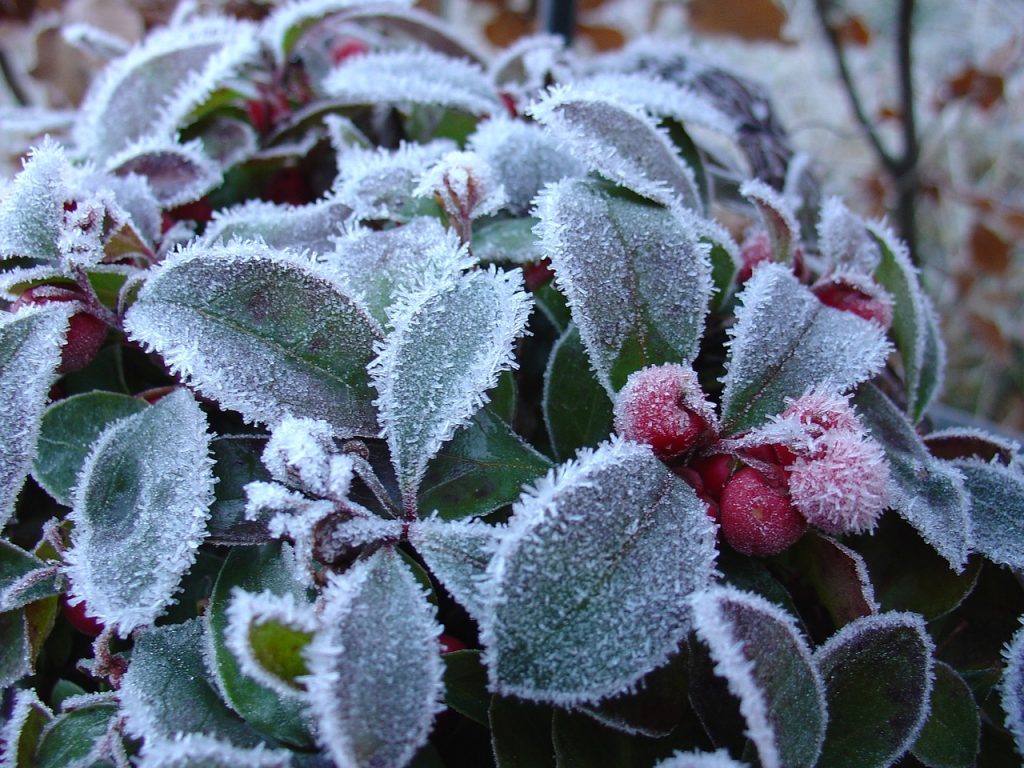
Wintergreen, scientifically known as Gaultheria procumbens, adds both charm and practicality to winter pot displays. Renowned for its evergreen foliage that remains vibrant through the snow, wintergreen showcases glossy, dark green leaves and produces small, delicate white or pale pink flowers in late spring. After blooming, it forms attractive red berries that persist through winter, making it not only a beautiful choice but also a functional one – these berries can attract birds to your garden.
Putting wintergreen in pots provides an opportunity to watch this resilient plant thrive in various conditions. It prefers acidic, moist soil, so incorporating peat or an acid-based potting mix will provide the right environment. As for light, wintergreen flourishes in partial to full shade, making it suitable for areas that may not receive direct sunlight.
For an eye-catching winter arrangement, pair wintergreen with textural companions such as heucheras or ferns. This approach will create a more sophisticated and layered display, providing depth and variety while ensuring that your winter pots remain visually appealing through the coldest months.
Primulas
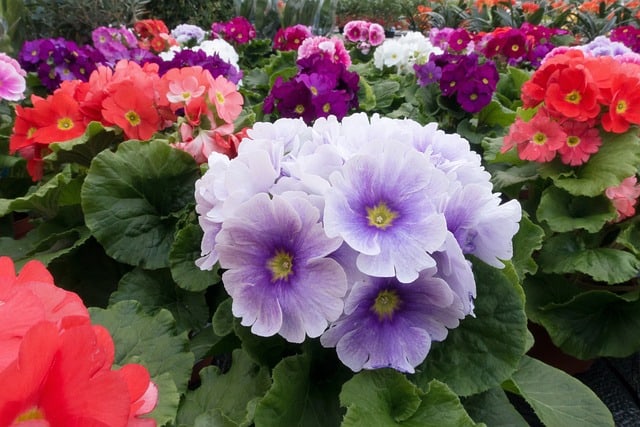
Primulas, commonly known as primrose, are delightful flowers that thrive in winter pots, offering a spectacular splash of color when many other plants are resting. Available in a plethora of colors, from cheerful yellows and soft pinks to vibrant reds and purples, primulas bring bright, cheerful blooms during winter and can last into early spring. Their rosette-shaped leaves add extra texture even when blooms are less prominent.
These hardy flowers prefer cooler temperatures, making them an ideal fit for winter arrangements. They thrive in well-draining soil enriched with organic material, allowing them to retain sufficient moisture without becoming waterlogged. For ideal results, position primulas in a spot that receives bright, indirect light, as too much direct sunlight can be detrimental.
For a striking winter display, consider combining primulas with ornamental grasses or other winter-blooming plants like pansies. This mixture will create a vibrant burst of color and texture, ensuring that your pots stand out against the muted tones of a winter landscape. Additionally, the juxtaposition of delicate primula flowers with sturdier foliage can produce a balanced and harmonious effect in your winter garden.
Winter Irises

Winter irises, particularly the Iris reticulata, are a captivating addition to winter pots, appreciated for their early blooms that bring a hint of spring to a winter garden. These dwarf irises are typically among the first flowers to emerge, showcasing striking, intricate flowers in rich blues, purples, and yellows. Their delicate petals and intriguing patterns make them a favorite for pot displays, instantly brightening any outdoor space.
For successful winter iris cultivation, plant the bulbs in a well-draining potting mix, ensuring that they are at a depth of approximately three times their height. Position your pots in a location that receives full sun, as these vivacious blooms thrive in bright light conditions. Although they are hardy to some frost, they’re best planted in containers that can be moved to warmer spots if the temperatures drop drastically.
To enhance the visual impact of winter irises in your pots, consider pairing them with other early-blooming companions like crocuses or snowdrops, creating a delightful mix of colors and forms. Beyond their beauty, these flowers can attract early pollinators, adding an essential element to your garden’s ecosystem as they emerge from their winter dormancy.
Winter Aconites
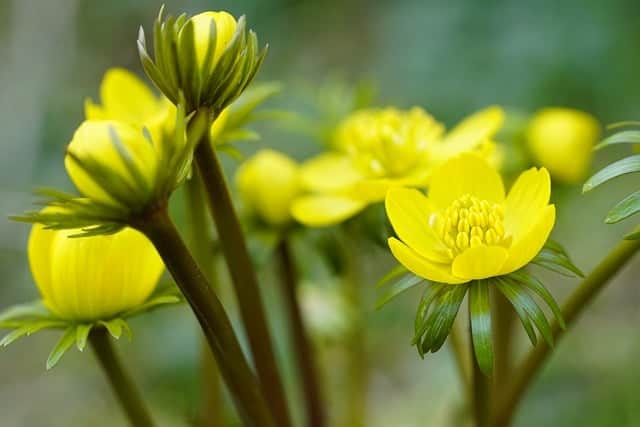
Winter aconites (Eranthis hyemalis) are enchanting little bulbs that bring a touch of freshness and color to winter pots. With their cup-shaped yellow flowers and glossy green leaves, these charming plants often bloom as early as January or February, heralding the arrival of spring long before most other blooms. Their bright yellow petals serve as a beacon of hope during the gray days of winter, bringing joy to any outdoor space.
To cultivate winter aconites in pots, select a well-draining soil mix that retains moisture but avoids becoming waterlogged. Plant the bulbs about 2-3 inches deep and positioning them in partial shade to full sun will yield the best results. They prefer cooler temperatures, making them perfectly suited for winter pots. However, be mindful that while they require moisture, particularly during their growing season, they need good drainage to thrive.
Combine winter aconites with early-blooming companions like snowdrops or crocuses for a stunning display that captures the attention of passersby. Their vibrant yellow hues contrast beautifully with the white and purple of other early spring flowers, ensuring your winter pots provide eye-catching beauty in an otherwise stark season.
Euonymus (Wintercreeper)

Euonymus, particularly varieties like Euonymus fortunei, commonly known as wintercreeper, is a versatile and hardy evergreen that adds lush greenery to winter pots. Known for its dense, trailing foliage, wintercreeper can provide year-round interest due to its vibrant green leaves and colorful variegation. In winter, its bright green hues stand out against the often bleak backdrop, making it an excellent choice for dynamic container displays.
Wintercreeper thrives in a variety of conditions, from full sun to partial shade, making it adaptable for different pot placements around your garden. When using euonymus in pots, it’s essential to use a well-draining soil mix and to ensure appropriate watering, as this plant prefers moist, but not soggy conditions. Regular pruning can help maintain its shape and promote bushiness, especially in container settings.
For a visually stunning winter arrangement, consider pairing euonymus with seasonal shrubs or conifers for added texture and height. The evergreen nature of wintercreeper will provide a lovely backdrop for other winter flowers like primulas or hellebores, creating a harmonious display that captures the essence of winter while maintaining visual interest.
Vinca (Creeping Myrtle)
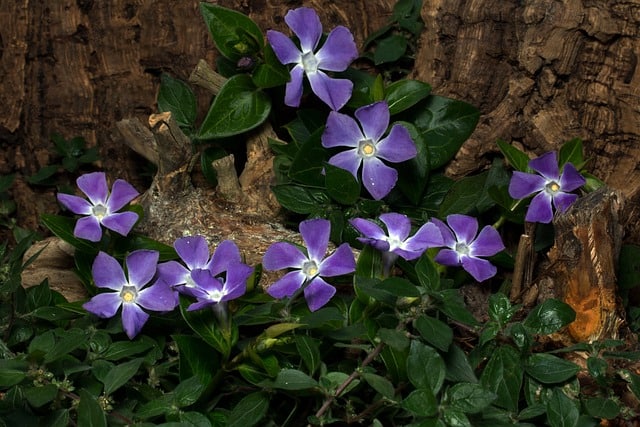
Vinca, also known as creeping myrtle or periwinkle, is a charming perennial that makes an excellent choice for winter pots. Recognizable by its glossy leaves and enchanting star-like flowers, vinca produces delicate blooms in shades of blue, purple, and white. During winter, this hardy plant continues to show off its attractive green foliage, while its blooms can emerge during the warmer days of late winter, adding delicate color to your container arrangements.
For successful cultivation, vine in pots should be planted in well-draining soil and positioned in partial shade to full sun. Vinca is a drought-tolerant plant, making it relatively low-maintenance and an excellent choice for busy gardeners. However, occasional watering, especially during dry spells, will help maintain its vibrant appearance.
To maximize the allure of vinca in your winter pots, consider combining it with low-growing evergreens, such as dwarf conifers or ornamental grasses. This strategic layering can create varied heights and textures in your arrangement, ensuring that your winter display is not only beautiful but also rich in contrast.
Ornamental Kale
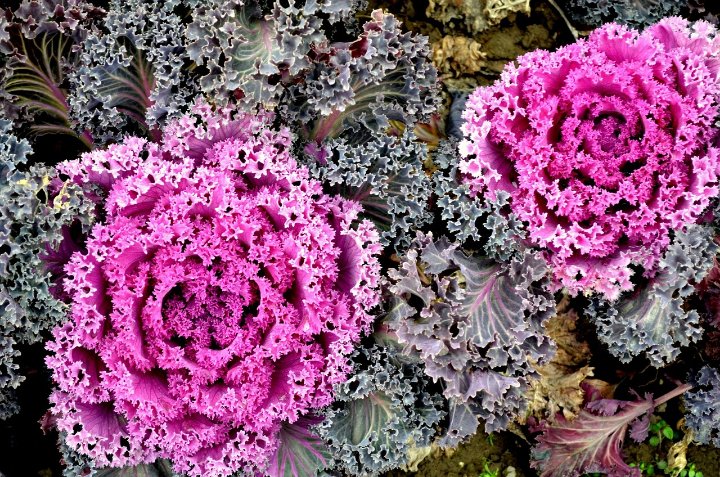
Ornamental kale, also known as flowering kale (Brassica oleracea var. acephala), is an exquisite and vibrant addition to winter pots, celebrated for its rich hues and ruffled texture. Unlike traditional edible kale, ornamental varieties are cultivated primarily for their striking appearance rather than taste. With colors ranging from creamy white and soft pink to deep purple, these kale plants can elevate any winter container garden into a veritable tapestry of color.
One of the key advantages of ornamental kale is its hardiness; it thrives in cooler temperatures, making it ideally suited for winter arrangements. When planting in pots, a well-draining, nutrient-rich potting mix is essential to allow the plants to establish robust root systems. Ornamental kale requires bright, indirect sunlight to flourish, so select a pot location that offers sufficient light while protecting it from harsh wind.
For a captivating winter display, consider combining ornamental kale with other textured foliage such as pansies or cyclamen. The ruffled edges of kale contrast beautifully with the delicate petals of these companion plants, creating a visually striking combination. Remember to keep the kale evenly watered, as this will help retain their vibrant colors and ensure their durability through the cold months.
Winter Heather
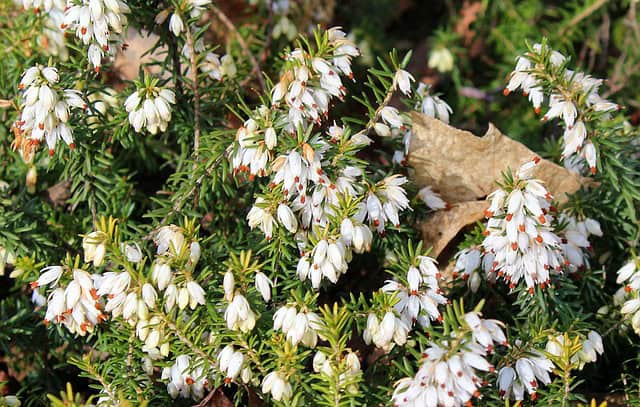
Winter heather (Erica species) is a splendid flowering shrub that introduces a burst of color to winter pots with its bell-like flowers. Ranging from white and pink to deep purple, these small blooms often bloom from late winter to early spring, providing delightful spots of color even amidst frost. In addition to its beautiful blooms, winter heather possesses leathery evergreen leaves, adding a soothing green backdrop throughout the colder months.
For growing winter heather in pots, well-draining acidic soil is a must. Amending a potting mix with peat moss or pine bark can create the optimal environment for this acid-loving plant. Winter heather typically prefers full sun, so placing your pots in a location that receives plenty of sunlight will encourage vigorous growth and abundant blooms.
To enhance your winter arrangements, consider pairing winter heather with other hardy perennials like sedums or low-growing conifers. The blend of textures and blooms will create a rich and diverse visual experience, making your pots a focal point even during the frostiest days. The winter heather not only provides aesthetic appeal but also serves as an important nectar source for early pollinators when it begins to bloom.
Coral Bells

Coral bells (Heuchera) are another stunning addition to your winter pot collection, known for their striking foliage that can range from deep burgundies and purples to bright lime greens. Though primarily noted for their colorful leaves, these perennial plants also produce tiny bell-shaped flowers on slender stems during the warmer months. While coral bells may not bloom during the heart of winter, their foliage adds substantial texture and interest to pot displays.
These perennial gems prefer well-draining soil and thrive in conditions that provide partial shade to full sun. When planting coral bells in pots, choose a container with ample drainage holes to prevent stagnation, as these plants resent overly wet conditions. Regular watering and occasional fertilization during the growing season will enhance their vibrancy and health.
To create engaging winter arrangements, combine coral bells with other hardy flowers like winter aconites or primulas. The diverse colors and leaf shapes of coral bells can serve as an attractive backdrop for the vibrant blooms of these companion plants. Creating layers in your winter pots with coral bells will ensure a captivating visual display, even in the depths of winter, making them a reassuring sign of the beauty to come in spring.
Bergenia
Bergenia, often called pig squeak due to the unique sounds its thick leaves produce when rubbed, is a captivating perennial that offers hardy charm to winter pots. With its leathery foliage, Bergenia is known for its ability to withstand harsh weather while retaining an attractive appearance. Its leaves can range from deep green to striking burgundy, presenting a beautiful tapestry of colors even in winter, while it bursts into clusters of pink or white flowers when spring arrives.
This versatile plant loves damp, well-draining soil and performs best in partial shade to full sun. Bergenia is quite resilient, making it suitable for container gardening during winter. When planting in pots, ensure they are adequately sized to accommodate blooms along with the eventual spread of the leaves.
To create a layered aesthetic, pair Bergenia with other perennials known for their textured foliage, such as coral bells or ornamental grasses. This combination can create a rich landscape where varying leaf shapes and sizes enhance each other, ensuring visual interest throughout winter. Moreover, the vibrant blooms of Bergenia will provide a delightful surprise in early spring, signaling the seasonal change.
Carex ‘Red Rooster’
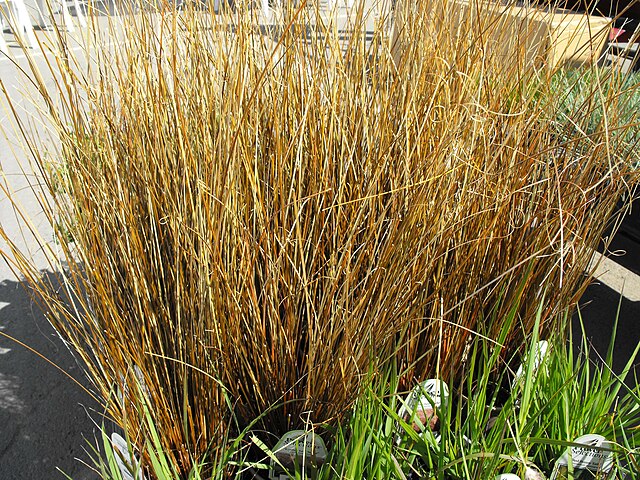
Carex ‘Red Rooster’ is a striking ornamental grass variety known for its vibrant red foliage that adds a dramatic flair to winter pots. This hardy sedge features narrow, arching leaves that transition from deep green at the base to striking reddish-brown tips, creating a warm and inviting aesthetic that contrasts beautifully against the landscape blanketed in snow. Whether planted alone or used as a dynamic filler in arrangements, ‘Red Rooster’ manages to elevate any winter display with its unique character.
This ornamental grass thrives in both sun and partial shade, making it an adaptable choice for various pot placements. It prefers well-draining soil enriched with organic matter, which aids in retaining moisture without letting roots sit in water. Regular watering is essential, especially during dry spells, to maintain the vibrancy of its foliage.
For a visually captivating winter display, consider mixing Carex ‘Red Rooster’ with other plants that complement its hues, such as winter heather or ornamental kale. This combination creates a textural contrast—while the bold blades of ‘Red Rooster’ rise gracefully, the round blooms of heather and kale add color and brightness, making your winter pots a focal point in your garden.


